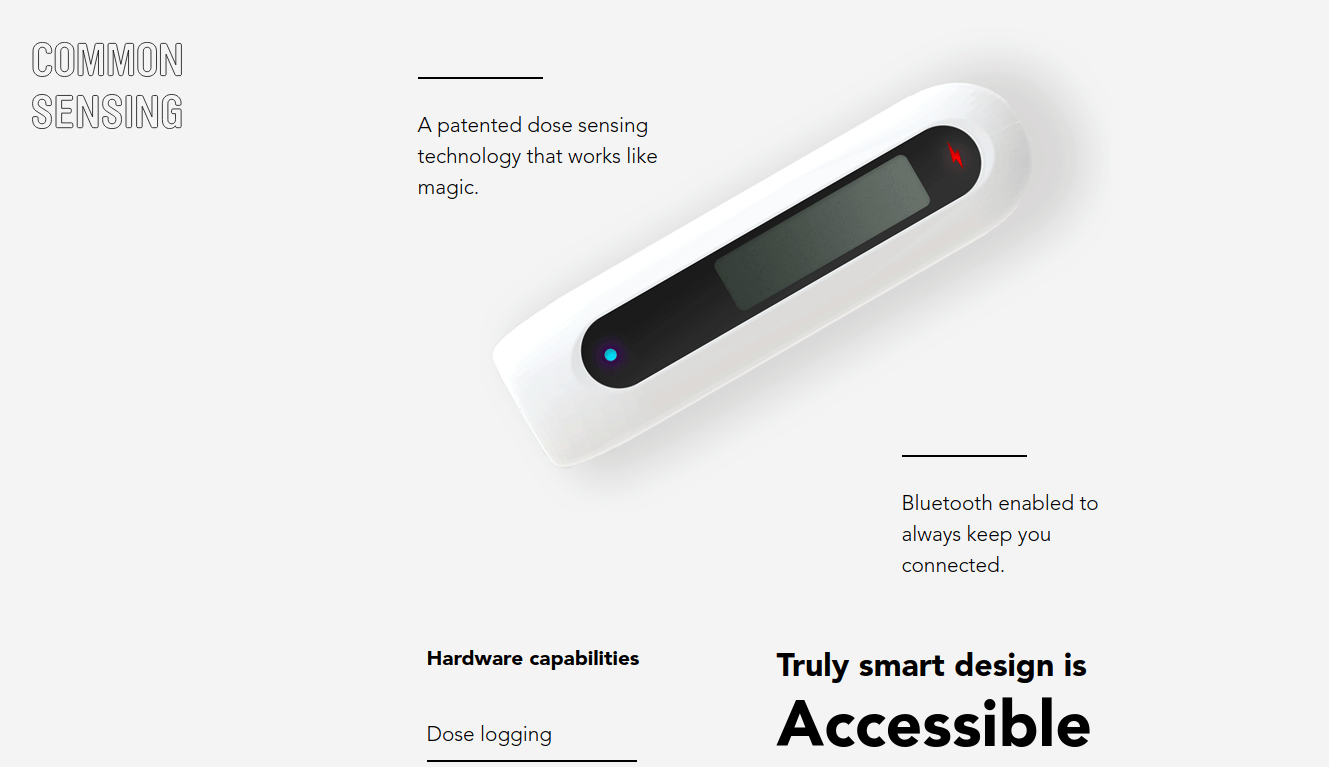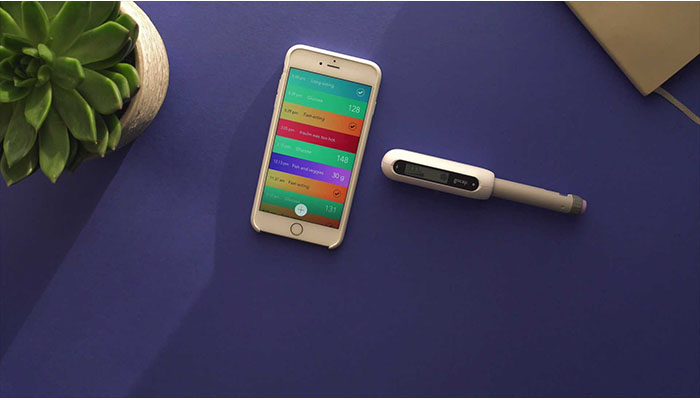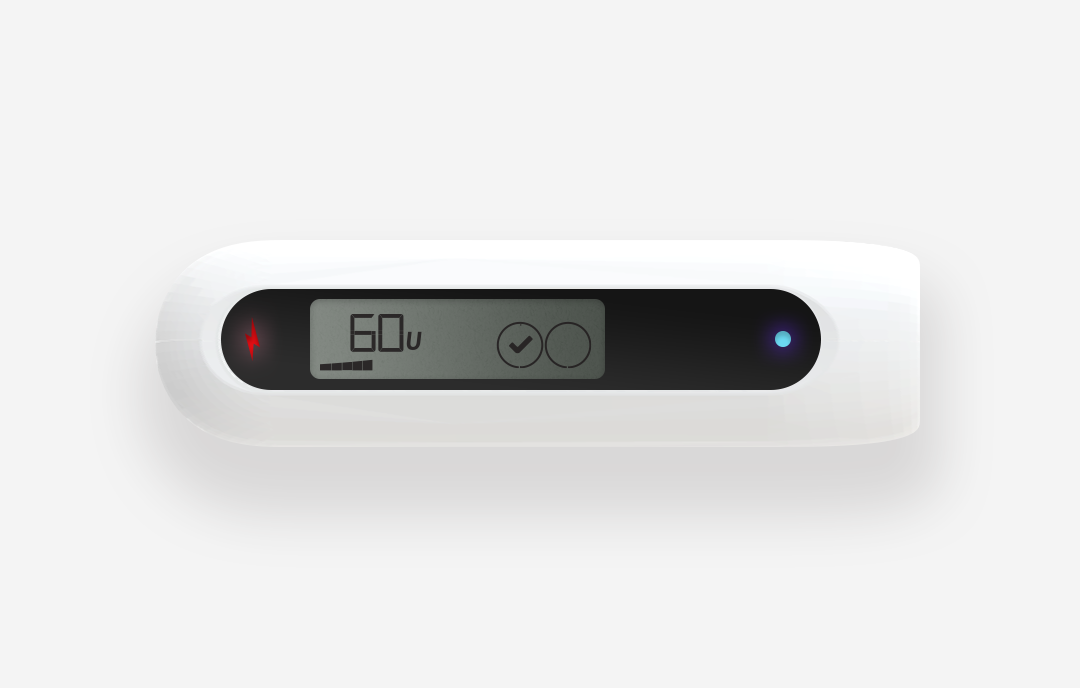
Common Sensing succeeded in bringing a novel smart hardware device from concept to market in a difficult space.
Common Sensing is an healthcare technology company we created to transform the home treatment of chronic disease, pioneering a new approach in a highly regulated and challenging market. Through deep insights into user needs and a commitment to meaningful impact, we reimagined how people manage chronic conditions from home. By developing a smart hardware device, Common Sensing empowered individuals to take control of their health in a space where such advancements have been limited, carving a unique position in the health tech landscape.
Our hardware product, Gocap, was designed to address a significant gap in chronic disease management, particularly for diabetes — the costliest chronic condition in the United States. We recognized that true success in managing diabetes is largely determined outside of clinic walls, in the daily routines and environments of the patients themselves. With this understanding, we developed a connected health device that integrates seamlessly into users' lives, helping them better manage their condition and, ultimately, improve their health outcomes.
Gocap stands out from other products due to its human-centered design approach. Common Sensing engaged directly with hundreds of users to learn about their daily challenges and preferences, which allowed the team to design a product that directly addresses real needs. This collaborative, user-focused process also helped the company navigate complex regulatory and adoption barriers, ensuring that Gocap met both the stringent requirements of healthcare regulation and the functional needs of users. By solving these challenges, Gocap became more than a medical device; it became an empowering lifestyle tool that inspires users to take an active role in managing their health at home.
We created Gocap, a connected health product that acts as a “Fitbit for injectable medicine”.
In the United States, over $200 billion in direct medical costs are attributed to diabetes, a chronic condition with a substantial economic burden. Surprisingly, more than half of diabetes patients are not meeting their treatment goals, which underscores a crucial gap in existing healthcare solutions. To put this into perspective, the size of the diabetes treatment market is comparable to the entire consumer electronics industry, yet if half of Americans struggled this way with all consumer electronics, it would likely signal an industry crisis.
I met my cofounders, Rich and Jamie, following a service design initiative I led at IDEO focused on insulin adherence. This experience shed light on the challenges that diabetes patients face in consistently tracking their insulin use. Gocap was conceived to directly address these challenges as a smart, connected cap for insulin pens. This innovative device captures each dose without disrupting the patient’s flow, logs data seamlessly via Bluetooth to a smartphone app, and allows users to share their dosing information with clinicians in real time. The product's design was intentional to ensure ease of use and integrate into the daily lives of diabetes patients without adding complexity or stress.
With Gocap, patients are not only able to track their insulin doses between doctor visits, but they are also surrounded by a proactive support network that fosters better adherence and treatment success. By enabling real-time data sharing with clinicians, Gocap provides an additional layer of support and accountability. This real-time feedback loop helps both patients and healthcare providers catch potential issues early and adjust treatment as needed, empowering individuals to take control of their health and promoting a collaborative approach to chronic disease management. Gocap thus serves as more than just a monitoring device; it actively supports lifestyle adjustments and fosters a sense of community and connectedness in the journey to manage diabetes effectively.
How Gocap works
Gocap is designed to fit seamlessly into a user's daily routine, replacing the disposable injector pen’s plastic cap with a smart version. This new cap functions just like a standard cap: users simply remove it to take a dose and put it back on when finished. However, Gocap goes further by recording each dose automatically, capturing the exact amount of medication taken. This information is then securely transmitted to the user’s mobile app via Bluetooth, keeping an up-to-date log without requiring manual entry.
The companion mobile app is essential to the Gocap experience. It gives users a real-time view of their dosing history and patterns, helping them stay informed about their treatment. Additionally, users can share this data with healthcare providers, allowing for continuous monitoring and support between doctor visits. Gocap’s automation and app integration make it easy for users to manage their treatment while also creating a detailed, accessible record for themselves and their care teams.
Common Sensing was a connected health technology company with $13.9M total funding, acquired by Bigfoot Biomedical.
The smart cap replaces the existing plastic cap that comes with insulin (and other medicine) disposable injector pens. When a user takes a dose, they simply remove the cap and place it back when finished. Gocap logs the dose amount and transmits it to the user’s companion mobile app over Bluetooth.
Getting the hardware right
Designing IoT hardware like Gocap is challenging due to the limited chances to iterate once production begins. While early prototypes were created using on-demand 3D printing, the shift to full-scale production required expensive ABS molds, costing up to $80K each. This high initial cost means the product needs to be nearly flawless by the time it reaches manufacturing, as changes become costly. Every design decision had to balance innovation with long-term efficiency, making the process meticulous and collaborative.
One of the most significant changes in Gocap's development was moving from an LCD to an OLED display. While the original LCD was suitable for showing basic information, expanding Gocap to work with multiple treatment types required a more adaptable display. The OLED screen provided a versatile interface that could accommodate various information displays on a single SKU. This adjustment allowed for a streamlined design that could handle different user needs without requiring separate hardware versions, making Gocap both versatile and scalable for broader use.
I was particularly interested in the perceived differences in objects we have to use and objects we want to use. Many objects that meet health needs are perceived as scary, unappealing, or unworthy of public display. Not so for eyeglasses; They're an article of fashion, even though they serve a medical purpose — correcting vision. What's the delta between eyeglasses and a hearing aid?
Gocap consists of an inner and outer plastic shell, a flexible printed circuit board, and a lens cover above the display.
The measurement hardware uses an array of infrared LEDs and a corresponding array of sensors that sit on either side of the injector pen cavity.
By placing Gocap's industrial design and user experience solidly within the design language of consumer wearables and other lifestyle products, we created a tool that people actually wanted to incorporate into their daily routine, and develop positive relationships with.
Co-designed by Gocap users
To ensure Gocap was intuitive and practical, especially for older adults managing diabetes, we conducted hundreds of hands-on usability studies, including one-on-one interviews and simulated-use sessions. Each study provided real-world insights into how different users handled the device, revealing subtle but important design adjustments to make Gocap accessible and reliable for everyone. With terabytes of GoPro footage, we captured every movement, challenge, and triumph as users interacted with early Gocap prototypes, allowing us to refine every detail from grip comfort to display readability.









These studies were not only vital for designing with human factors in mind but also aligned with FDA guidelines on user-centered design, which emphasize the importance of thorough usability testing for medical devices. By incorporating real feedback from Gocap users at every stage, we identified and resolved potential usability barriers, reducing risks and improving the overall experience. This collaborative, iterative approach ensured that Gocap wasn’t just functional but felt empowering and accessible to its users, delivering a product that genuinely met their needs.
Packaging design for easy onboarding
Since Gocap wouldn't always be deployed in person, It was important users would be able to set up Gocap with their injectable medicine, charge their Gocap, download and install the Gocap App, and sync Gocap to their device over Bluetooth, all without intervention. Gocap's packaging design made this possible by providing affordances and education during the unboxing process.
Gocap App featured design innovations that threw conventional UI out the window.
Designing the Gocap App presented unique challenges and opportunities as we worked with a user base that included many first-time smartphone users. Over a third of prospective users had never owned a smartphone before, so we had to rethink conventional digital design norms, which often rely on familiarity with features like gestural interaction and common icons. These users were new to the digital semiotics many of us take for granted, so traditional affordances and cues were ineffective for this audience. To create an accessible, user-friendly app, I designed an interface for iOS and Android based on innovative, simplified guidelines:
- No navigational UI.
Menus, drawers, and tabs were eliminated to prevent essential information from being hidden or difficult to find. The interface was designed to be as direct as possible.
- One screen, one action.
Each screen shows only what users need to see at that moment, reducing cognitive load and guiding them step-by-step through their tasks.
- Low reliance on iconography.
Icons were minimized and replaced with clear text labels, allowing users to understand and interact without needing to interpret unfamiliar symbols.
- Use color to create a sense of category and place.
Consistent color-coding for core categories like medication types, glucose levels, and alerts helped users quickly orient themselves and understand each section’s purpose at a glance.
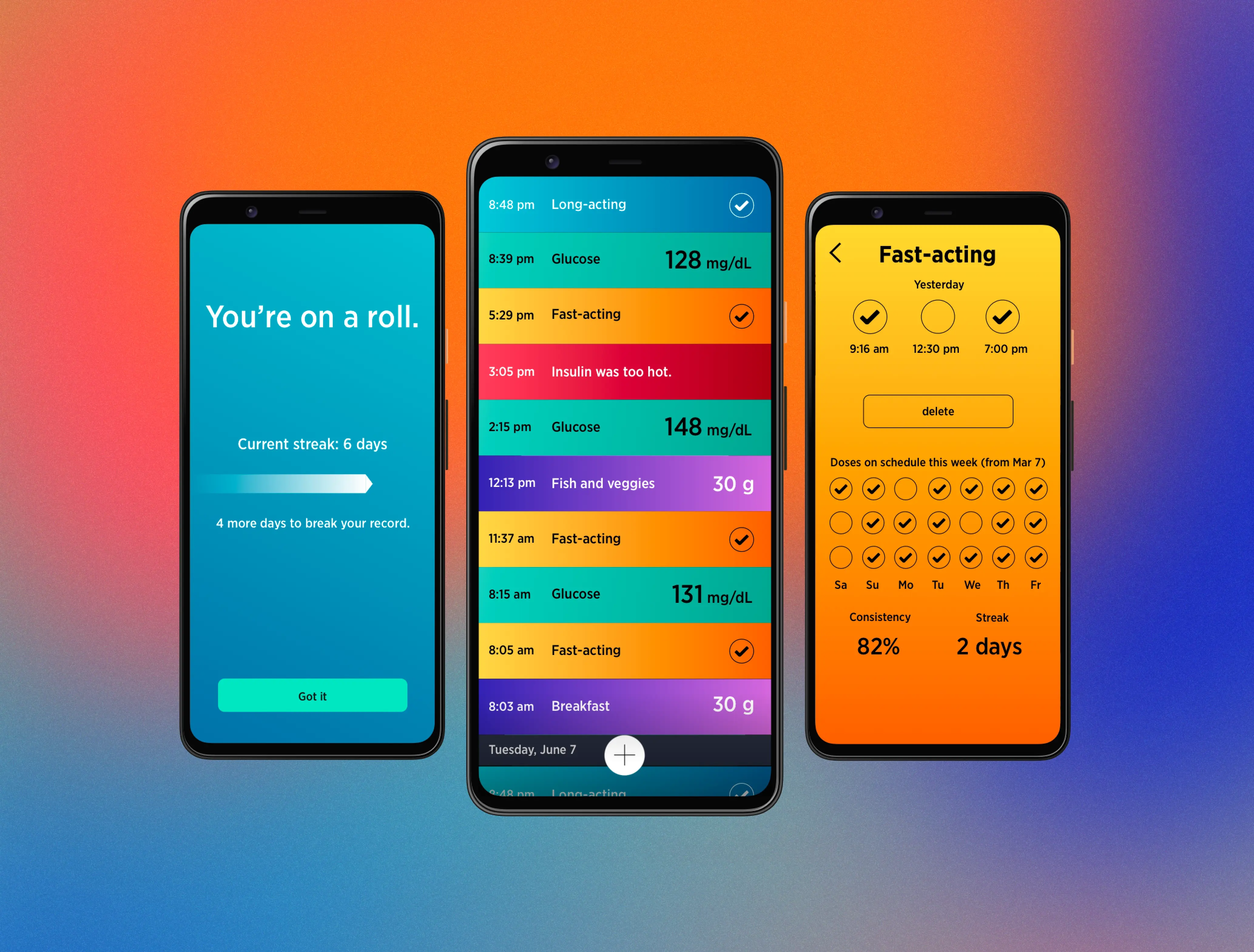
Gocap Dash let care providers focus on patients that need their attention.
The care ecosystem for injectable medicine is intricate, involving not only patients but also their families, caretakers, healthcare providers, payers, and pharmacies. This network requires careful coordination to ensure patients receive optimal support, yet existing solutions often fall short in integrating real-time data across these groups. Gocap addressed this by enabling data sharing with approved parties throughout this ecosystem, delivering insights that reduce costs and improve care quality. By providing timely and accurate data directly to those involved, Gocap enhanced communication and enabled each group to respond more proactively to patient needs.
To support healthcare providers, we developed Gocap Dash, a web application that highlights actionable insights from patient data. Gocap Dash organizes patient information at a population level, categorizing individuals by risk and identifying those in need of immediate intervention. Real-time dose information allows providers to monitor adherence closely, while built-in analytics identify behavioral patterns linked to treatment outcomes. This tool helps care teams make data-driven decisions, prioritizing time and resources for patients who require attention most urgently, ultimately making the entire treatment network more efficient and responsive.
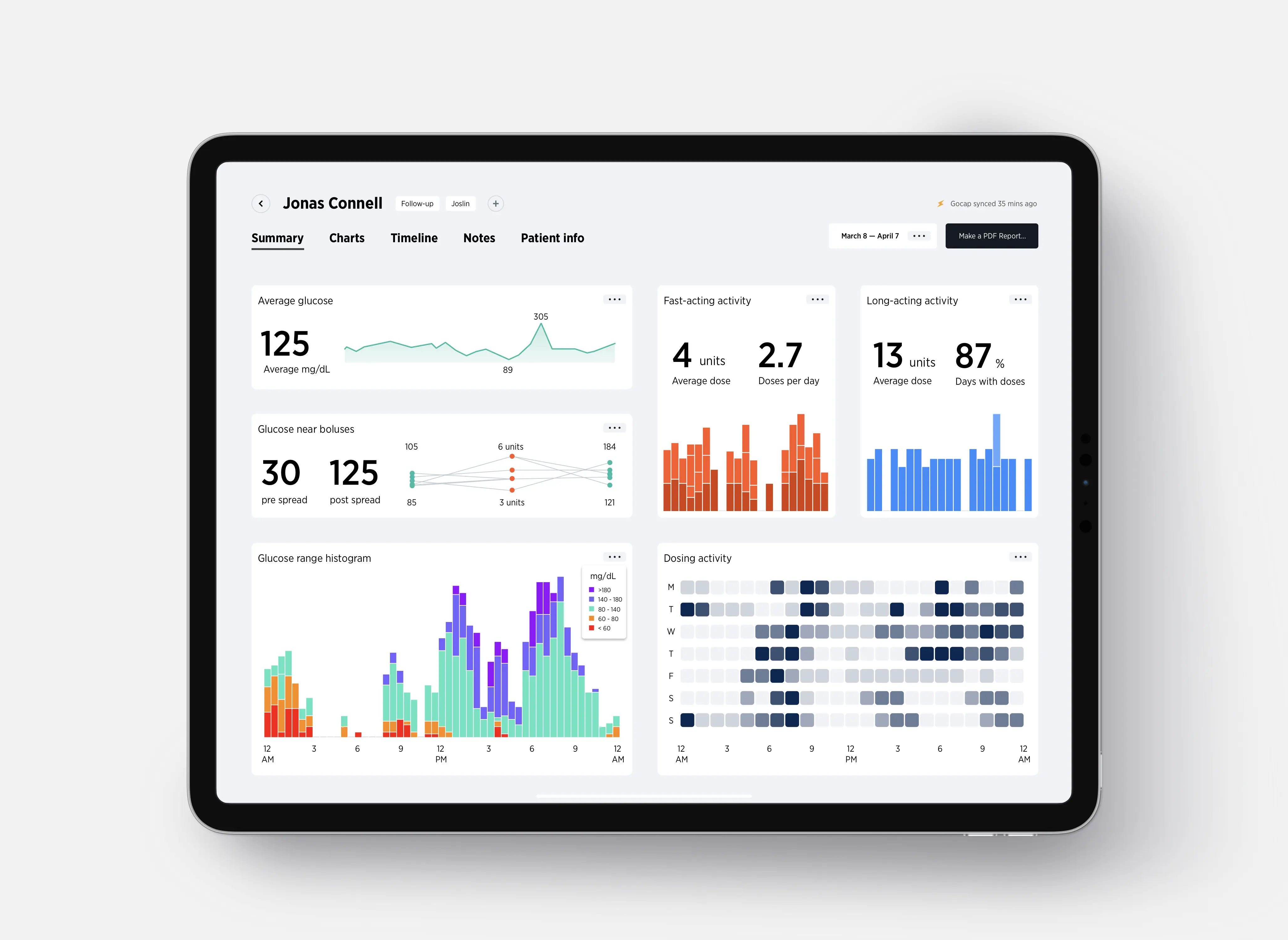
Gocap Dash is a web application for care providers that shows population-level stratification, real-time dose information, categorizes patients based on risk, identifies intervention needs, and characterizes correlated behaviors.
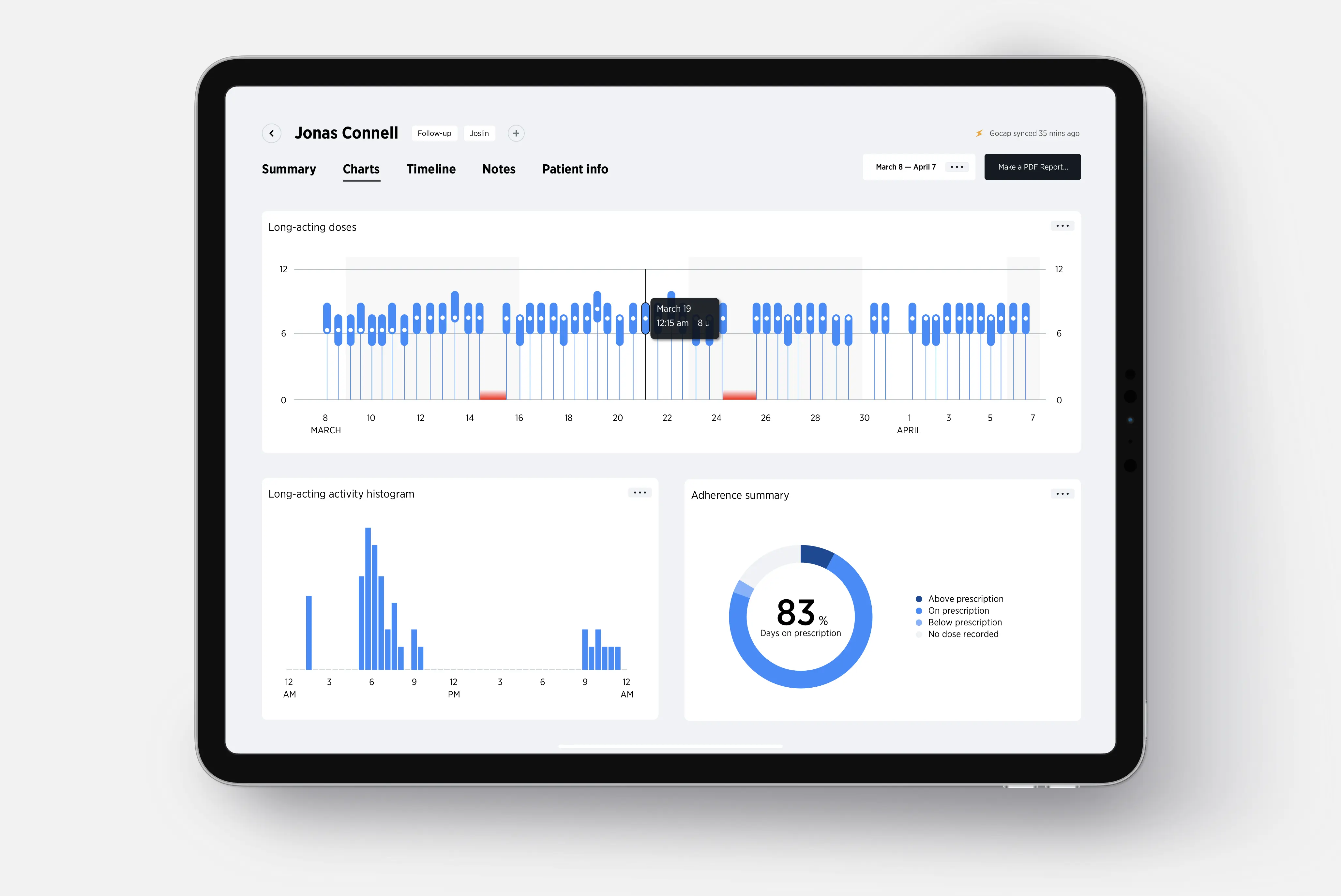
Gocap Dash is a web application designed for healthcare providers to monitor and manage patient populations. It provides real-time dose information, categorizes patients based on risk levels, identifies intervention needs, and characterizes correlated behaviors to enhance patient care.
A unique problem: optimizing for fax machines
Gocap Dash is powerful, but not everyone in the care ecosystem could take advantage of that power. Hospitals, especially, can be hobbled by red tape or antiquated processes. We found that many care providers were stuck using older computers (running Windows XP after its end-of-life), or weren't able to connect to the internet from systems where they handled patient information. We discovered that sending patient records over fax was one of the most common methods for transferring and viewing protected health data. Generally, faxing is HIPAA-compliant as it offers end-to-end security.
To handle this, we implemented PDF exports and direct-to-fax capability. Additionally, we optimized the data visualizations in exports to render well in the low-pixel scan area available in a typical fax.

Clinical outcomes
In partnership with the Joslin Diabetes Center, we conducted a pioneering connected health study that revealed the tangible impact Gocap has on clinical outcomes for diabetes patients. The study demonstrated that Gocap users experienced improved health outcomes, including better insulin adherence and a reduction in missed doses, highlighting the effectiveness of a connected approach to chronic disease management. By seamlessly integrating into users’ routines, Gocap empowered patients to manage their condition more consistently, showing that connected health technology can be a powerful tool in tackling one of the most challenging aspects of diabetes care.
Beyond individual outcomes, the study unearthed valuable insights into insulin use behavior on a broad scale. For the first time, we were able to document widespread challenges with insulin dosing, identifying specific patterns of non-adherence that had previously gone unnoticed. This new behavioral data equips healthcare providers with critical information, enabling them to address these issues proactively. The findings have also informed the development of new clinical strategies, allowing for more personalized treatment approaches and ultimately improving care standards for diabetes patients as a whole.
Brooke H. McAdams and Ali A. Rizvi. An Overview of Insulin Pumps and Glucose Sensors for the Generalist.
Israel Hodish, MD, PhD. Decades Into Diabetes, Insulin Therapy Still Hard to Manage.
Medha N. Munshi, Christine Slyne, Tara MaNeil, Joslin Diabetes Center, Harvard Medical School, et al. Nonadherence to Insulin Therapy Detected by Bluetooth-Enabled Pen Cap Is Associated With Poor Glycemic Control.
Toschi E, MD, Carl S, Greenberg J, BS, Greaves T, BS, Atakov-Castillo A, BA, Slyne C, BA, Munshi M, MD. Use of Gocap to evaluate appropriateness bolus insulin dosing to achieve target glucose levels in patients on basal bolus regimen.
Brooke H. McAdams and Ali A. Rizvi. An Overview of Insulin Pumps and Glucose Sensors for the Generalist.
Israel Hodish, MD, PhD. Decades Into Diabetes, Insulin Therapy Still Hard to Manage.
Gocap serves more than 7 million patients whose data was previously invisible to their clinicians and themselves.
Gocap’s journey began with a mission to bring transparency and support to millions of patients and clinicians who lacked real-time access to critical treatment data. After proving Gocap’s safety, efficacy, and usability through rigorous trials, we partnered with connected glucose meters and injectable pens to offer Gocap as part of comprehensive, bundled solutions. This approach “closed the loop” for clinicians and patients alike, transforming how treatment is managed. Clinicians gained a clear, data-driven view of their patients’ adherence, allowing them to tailor care strategies, while patients received the insights they needed to take control of their treatment with confidence.
As Gocap matured, we expanded its reach beyond insulin to other high-risk injectable medications, such as hormone therapies and fertility treatments. By broadening Gocap’s capabilities, we opened new opportunities to support more patients in managing complex conditions and helped healthcare providers track and optimize treatment for a wider range of medications. Today, Gocap serves over 7 million patients, making once-invisible data accessible and actionable for users and their care teams.
Acquisition & Exit
In 2021, Common Sensing was acquired by Bigfoot Biomedical,, marking an exciting new chapter for Gocap. By joining Bigfoot, Gocap became part of a fully integrated diabetes care solution, combining the power of connected glucose monitoring, insulin management, and treatment adherence. Bigfoot’s resources and established infrastructure made it possible to extend Gocap’s reach and impact, helping more patients benefit from comprehensive, real-time care data.
This acquisition aligned perfectly with our goal of maximizing patient access to Gocap while empowering clinicians with holistic insights. Bigfoot had already assembled the other essential pieces of the connected health puzzle, and integrating Gocap into this ecosystem allowed us to deliver a complete, seamless solution. Through Bigfoot, Gocap continues to make a meaningful difference in the lives of patients and their care providers, transforming how chronic disease is managed on a large scale.
